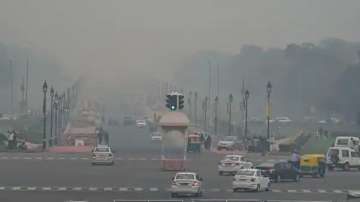Delhi's air quality moved closer to the "very poor" category on Monday morning, on the day of Diwali, as the unfavourable climatic conditions enabled pollutants to accumulate. In addition, stubble burning and the pollutants from the firecrackers further worsened the situation.
The city's Air Quality Index (AQI) was recorded at 298 at 6 am.
The air quality was recorded in the "very poor category" in 19 of the 35 monitoring stations, whereas, one station, Anand Vihar, reported reported "severe" pollution levels.
Meanwhile, poor air quality was observed in the nearby cities of Ghaziabad (300), Noida (299), Greater Noida (282), Gurugram (249), and Faridabad (248).
An AQI between 0 to 50 is regarded as "good," 51 to 100 as "satisfactory," 101 to 200 as "moderate," 201 to 300 as "poor," 301 to 400 as "very poor," and 401 to 500 as "severe."
The national capital's 24-hour average Air Quality Index (AQI) was 259 on Sunday evening, October 23, the lowest for the day before Diwali in seven years.
According to reports, the pollution level further crept up as people burst firecrackers in various parts of the capital at night and amid a dip in temperature as well as wind speed.
SAFAR, a forecasting agency under the Union Ministry of Earth Sciences, had earlier predicted that the air quality may deteriorate to "very poor" on Monday morning due to calm winds and low temperatures which allow rapid accumulation of pollutants in the air.
It will continue to remain "very poor" if no firecrackers are burst, it said.
In case firecrackers are burst like last year, the air quality may plunge to "severe" levels on the night of Diwali and continue to remain in the "red" zone for another day, SAFAR predicted.
The contribution of stubble burning to Delhi's PM 2. 5 pollution has so far remained low (up to 5 per cent) due to a slow transport-level wind speed.
But, it is likely to increase to 8 per cent on Monday.
Gufran Beig, founder project director, SAFAR, said the transport-level wind direction and speed is likely to become "very favourable" for transport of smoke from stubble burning from Monday afternoon.
"It will increase the share of stubble burning in Delhi's PM 2. 5 pollution to 15-18 per cent on October 25 and push the air quality into the 'severe' category," he said.
The Indian Agricultural Research Institute reported 902 farm fires in Punjab, 217 in Haryana and 109 in Uttar Pradesh on Sunday evening.
(With inputs from PTI)
Also Read: One day before Diwali, AQI still in red at 266; govt puts strict pollution curbs in place
Latest India News

